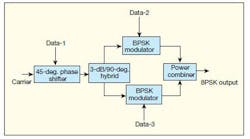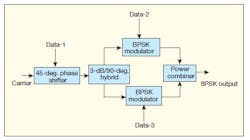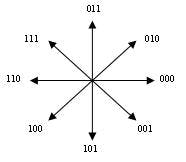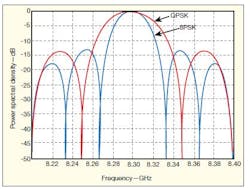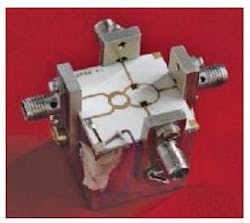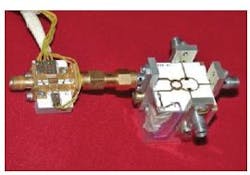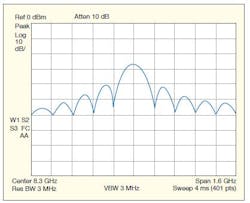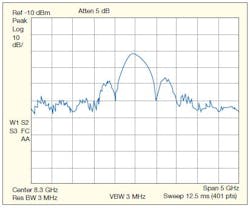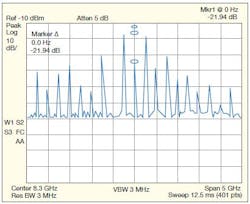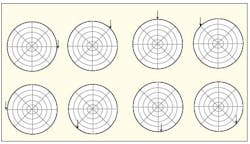Satellite communications (satcom) offer ubiquitous service coverage from space, albeit with limited bandwidth. As a result, service providers seek to use higher-order modulation schemes to achieve high data rates over limited available bandwidth. In support of high-speed data, an eight-state, phase-shift-keying (8PSK) modulator was designed for use at X-band satcom frequencies, with data rates as fast as 1.5 Gb/s. Fabrication of the modulator is straightforward, using standard commercial components, and performance was verified with a commercial microwave vector network analyzer (VNA).
Increasing demand for faster data communications has driven satcom system architects to strive for greater spectral efficiency and data transmission capacity. For example, Indian remote sensing (IRS) satellites, which are built by the Indian Space Research Organization (ISRO; www.isro.org), provide a variety of remote sensing services. These satellites use binary-phase-shift-keying (BPSK) and quadrature-phase-shift-keying (QPSK) modulation at S- or X-band frequencies to transmit payload data.
The data rates have progressively increased from 20.8, 21.25, 42.5, and 85 Mb/s to 105 Mb/s per carrier with QPSK modulation. The bandwidth available for data transmission at X-band carrier frequencies is 375 MHz. Two carriers at different frequencies are being used to transmit 210-Mb/s data from two different payloads. To transmit higher data rates, a QPSK modulator capable of transmitting 640 Mb/s on a single carrier with dual polarization is used.
Although QPSK modulation is a bandwidth- and power-efficient format, it cannot achieve the downlink data rates required to satisfy growing demands for data. As a result, higher-order modulation schemes like 8PSK have been considered. Of course, higher transmit power levels will also be needed in support of higher data rates and acceptable bit-error-rate (BER) performance (such as 1 x 10−6 for space communications). Still, a number of space-qualified high-power amplifiers (HPAs) are available from different vendors, making it possible to use 8PSK modulation for high-data-rate transmissions in remote sensing satellites.
A satcom system based on 8PSK is spectrally more efficient than one using QPSK, since 8PSK modulation can support about 1.5 times the data rate of QPSK modulation; the main lobe occupancy of 8PSK is two-thirds that of a QPSK spectrum. As an example, the total data rate that can be transmitted on a single carrier at X-band is 480 Mb/s when using 8PSK modulation. With 8PSK and dual polarization, the data rate can be increased to twice that, or 960 Mb/s.
In order to test these premises, an 8PSM modulator was designed and fabricated to explore the possibilities of high-data-rate communications at X-band frequencies. The 8PSK modulator was realized using a phase shifter and a QPSK modulator. The block diagram of the 8PSK modulator is shown in Fig.1. The QPSK modulator consists of a 3-dB/90-deg. hybrid, two BPSK modulators, and a power combiner. Three data streams are fed to the 8PSK modulator to create eight phase states. Two data streams are fed to the QPSK modulator to provide four phase states and the third data stream is fed to the phase shifter to select a phase state of either 0 or 45 deg.
1. This block diagram shows the basic components of the 8PSK modulator, including a pair of BPSK modulators, a phase shifter, and a power combiner.
The output of the 8PSK modulator will be 0, 90, 180, or 270 deg. for a phase-state selection of 0 deg. using the phase shifter. The 8PSK modulator will provide phase outputs of 45, 135, 225, or 315 deg. when the phase shifter is switched to its 45-deg. phase state. The eight phase states of the 8PSK modulator are shown in Fig. 2.
2. The eight phase states of the 8PSK modulator are realized by means of a phase shifter and a QPSK modulator.
For analysis purposes, the MATLAB mathematics-based simulation software from MathWorks (www.mathworks.com) was used to compare the spectral bandwidth of communications systems using QPSK and 8PSM modulation. As Fig. 3 shows, the bandwidth occupied by the main lobe of the 8PSK spectrum is two-thirds the bandwidth of the QPSK spectrum. The 8PSK modulator was fabricated with commercially available components. The 45-deg. phase shifter is a 5-b model TGP 6336-EEU device from TriQuint Semiconductor (www.triquint.com), which provides the choice of 0- or 45-deg. phase states. A photograph of the phase shifter in a test jig (for evaluation purposes) is shown in Fig. 4. One of the phase shifter’s inputs were selected based on 0- and 45-deg. phase shifts, respectively.
3. This MATLAB computer simulation shows that the bandwidth occupied by the main lobe of the 8PSK spectrum is two-thirds the bandwidth of the QPSK modulator’s spectrum.
4. This photograph shows the phase shifter used to realize the 8PSK modulator.
The QPSK modulator was designed and fabricated with a 3-dB, 90-deg. hybrid, a pair of BPSK modulators, and a Wilkinson power combiner. The hybrid and the power combiner were developed in-house, using microstrip circuit technology to achieve low-loss performance at X-band frequencies. The BPSK modulators consist of commercial double-balanced mixers, models HMC141 and HMC142 from Hittite Microwave Corp. (www.hittite.com), to reduce the size of the modulator. The QPSK modulator was fabricated on a 1 x 1 in. alumina substrate as shown in Fig. 5. An RF carrier at 8.3 GHz was fed to the hybrid, which in turn drove the local oscillator (LO) ports of the two mixers with equal-amplitude signals that were 90 deg. out of phase. The BPSK-modulated outputs from the mixers were fed to the power combiner to get QPSK modulation.
5. The QPSK modulator used in the 8PSK modulator design employs low-cost commercial double-balanced mixers as BPSK modulators and is realized on a 1 x 1 in. alumina substrate.
To characterize the QPSK modulator assembly, a commercial data generator from Agilent Technologies (www.agilent.com) was used to feed two data streams with levels of ±1.2 VDC to the modulator. Depending on the combinations of data inputs, four phase states were observed on a commercial vector network analyzer (VNA) from Rohde & Schwarz (www.rohde-schwarz.com).
The QPSK mod-ulator and the 5-b phase shifter were connected in series to realize an 8PSK modulator, as shown in Fig. 6. Although the 8PSK modulator was constructed with discrete components for this demonstration, it could also easily be fabricated on a single substrate. To evaluate its performance, an 8.3-GHz RF carrier and three data streams were fed to the modulator. The data levels were 0 and 5 V fed to the phase shifter and ±1.2 VDC fed to the QPSK modulator. The data bias levels used with the modulator impact the amplitude-imbalance, phase-imbalance, and carrier-suppression performance levels. It may be necessary to design an additional interface circuit matched to the input logic levels to optimize performance with actual data.
6. The QPSK modulator and phase shifter were connected in series to achieve an 8PSK modulator.
Although the maximum data rate required for X-band satcom systems is 3 x 160 Mb/s, the modulator was tested for data rates to 3 x 500 Mb/s. The spectra for pseudorandom-bit-sequence (PRBS) data at rates of 3 x 160 Mb/s and 3 x 500 Mb/s are shown in Figs. 7 and 8, respectively. The carrier-suppression levels obtained at the lower and higher data rates were −35.09 and −21.94 dBc, as shown in Figs. 9 and 10, respectively. The modulator was also tested for its eight output phase states using the VNA, with the output phase states shown in Fig. 11. From the constellation diagram, the amplitude and phase imbalance are ±1.3 dB and ±4.3 deg., respectively.
7. This spectrum is for PRBS data at 3 x 160 Mb/s.
8. This spectrum is for PRBS data at 3 x 500 Mb/s.
11. A commercial VNA was used to evaluate the eight output phase states of the 8PSK modulator design.
The table compares the essential requirements of an 8PSK modulator for satcom use with the measured performance of the X-band prototype. All of the measured values except amplitude imbalance meet the desired requirements. The relatively high amplitude imbalance of ±0.3 dB compared with the specification will result in a negligible degradation of energy per bit to noise density ratio (Eb/No) performance, which is acceptable. Carrier suppression at the lower data rate is higher due to the enhanced data characteristics in terms of rise/fall time.
In summary, an 8PSK modulator was developed to achieve higher data rates in a new generation of remote sensing satellites. The modulator can be used directly at X-band frequencies for transmitting data at rates to 480 Mb/s using the available bandwidth. When dual polarization is employed, data can be transmitted at rates to 960 Mb/s.
To fully evaluate the performance of the modulator, it was also tested and found capable of handling data rates to 1.5 Gb/s. Measurements of amplitude imbalance, phase imbalance, and carrier suppression show performance that is encouraging for use in future satcom systems.
